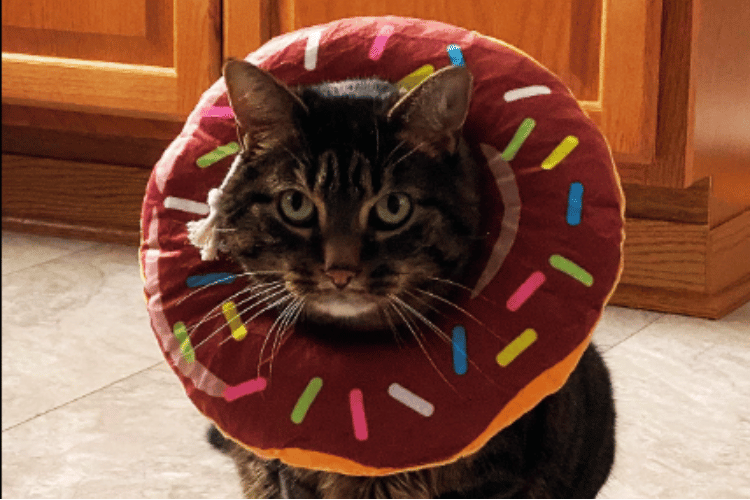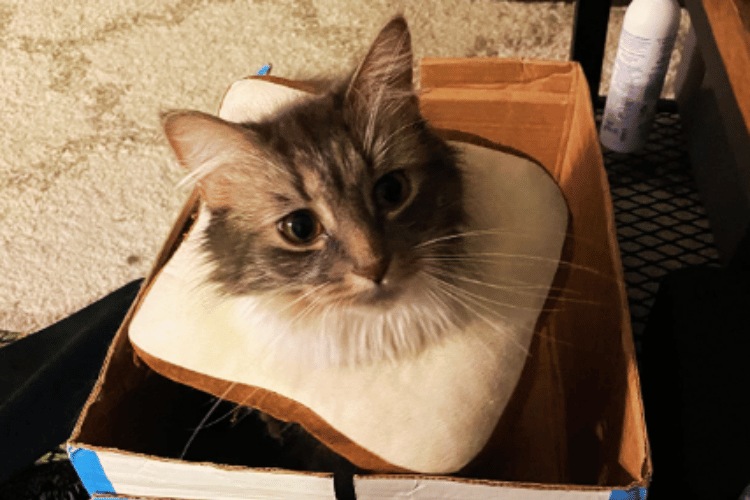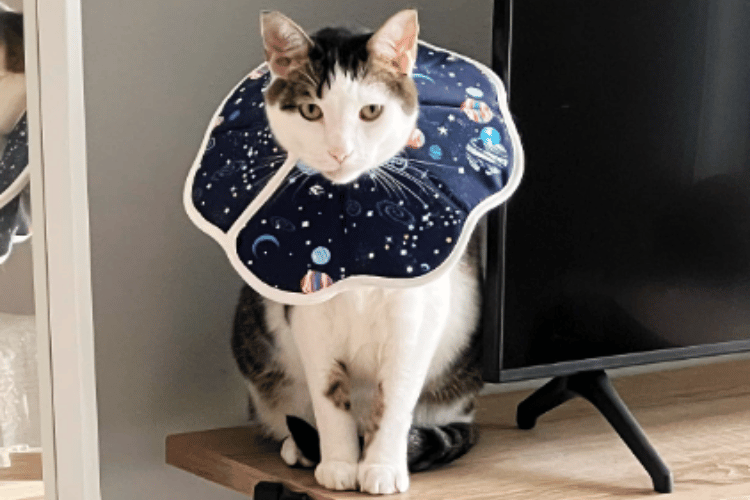Have you ever struggled with putting a donut collar on your furry cat? Donut collars, also known as e-collars, are used to prevent cats from licking or scratching their wounds or skin irritations.
However, as much as they are essential, they can be tricky to put on your feline friend. In this article, we will show you how to put a donut collar on a cat effortlessly.
We'll cover all the bases, including different types of donut collars, the right way to measure, and the best techniques to help your cat adjust to the collar.
If you have ever grappled with this problem, stay with us to learn a few tips and tricks.

Understanding Donut Collars for Cats
Donut collars, also known as E-collars or Elizabethan collars, can be a useful tool when it comes to preventing cats from licking or biting at a wound or irritation on their body.
If your cat has recently undergone surgery, has an injury, or suffers from an allergic reaction, you may need to use a donut collar to keep them from bothering the affected area.
But how do you put a donut collar on a cat? And how do you make sure they don't get uncomfortable or stressed while wearing it?
In this article, we'll explore all the ins and outs of donut collars for cats, including how to choose the correct size, how to fit the collar properly, and how to make sure your cat stays comfortable.
Choosing the Right Size Donut Collar
Donut collars come in a variety of sizes to fit cats of different breeds and sizes. When choosing a donut collar for your cat, it's important to measure their neck size to ensure a proper fit.
Use a soft measuring tape to measure the circumference of your cat's neck, about one inch below their ears.
Once you have their neck measurement, consult the size chart provided by the collar manufacturer to choose the correct size. If your cat falls in between sizes, choose the larger size to ensure a comfortable fit.
Fitting the Donut Collar Properly
Once you have the correct size donut collar for your cat, it's time to fit it properly. Place the collar around your cat's neck, making sure it sits comfortably and doesn't rub against their skin.
The collar should be snug but not too tight, and it should extend beyond their nose to prevent them from licking or biting at their body.
Some cats may be initially resistant to wearing a donut collar, so it's important to introduce it slowly and reward them with treats or positive reinforcement. You can also try putting the collar on during meal times or playtime to keep your cat distracted.
Keeping Your Cat Comfortable
Donut collars can be uncomfortable for cats, especially if they're not used to wearing them. To keep your cat comfortable while wearing a donut collar:
Keep the collar clean and dry, wiping it down with a damp cloth as needed.
Monitor your cat closely in the first few days to ensure they don't get irritated or stressed.
Provide plenty of water and food, making sure your cat can still eat and drink with the collar on.
Remove the collar periodically to give your cat a break and to inspect their neck for any irritation.
In conclusion, donut collars can be a helpful tool in keeping your cat from licking or biting at a wound or injury. By choosing the correct size, fitting the collar properly, and keeping your cat comfortable, you can help them heal quickly and safely.

FAQs About Putting a Donut Collar on a Cat
Do you have a cat that needs a donut collar but you don't know how to put it on? Don't worry, we've got you covered!
Putting a donut collar on a cat can be tricky, especially if you don't know what you're doing. It's important to make sure the collar fits properly and is secure, but it can be difficult to know how to do that.
We've compiled a list of the most frequently asked questions about donut collars for cats so you can know more about these collars and how to put them on your cat.
Why should I use a donut collar for my cat?
A donut collar, also known as an Elizabethan collar or e-collar, is commonly used to prevent cats from licking or scratching wounds, surgical incisions, or skin irritations. It helps to promote healing by creating a barrier between the cat and the affected area. Donut collars are essential in preventing self-inflicted injuries and infections.
How do I choose the right size donut collar for my cat?
When selecting a donut collar, it's crucial to consider your cat's size and comfort. Measure the circumference of your cat's neck using a flexible tape measure or string, then add a few inches for a comfortable fit. The collar mustn't be too tight to restrict breathing or eating, but snug enough to prevent your cat from slipping out of it.
What are some common problems encountered when using a donut collar?
Cats may initially find wearing a donut collar uncomfortable or distressing. They may try to remove it by scratching, biting, or rubbing against furniture. To address this, ensure a proper fit and gradually introduce the collar to your cat. Additionally, maintain a calm environment and provide plenty of distractions, such as toys or treats, to keep your cat occupied and alleviate stress.
How should I clean and care for my cat's donut collar?
Donut collars can become soiled or dirty over time, especially if your cat eats or drinks while wearing it. Most donut collars are made of easily wipeable materials, such as plastic or nylon. You can clean it with a damp cloth or mild soap. It's important to dry the collar thoroughly before reattaching it to your cat to prevent discomfort or skin irritation.
Are there any safety precautions I should take when using a donut collar?
While donut collars are generally safe and effective, it's important to monitor your cat closely during the wearing period. Ensure that your cat can eat, drink, and move comfortably without obstruction. If you notice any signs of distress, difficulty breathing, or excessive salivation, remove the collar immediately and consult your veterinarian for guidance.
Remember, each cat is unique, and their response to wearing a donut collar may vary. Patience, positive reinforcement, and gentle introduction are key to making this process as comfortable as possible for your feline companion.

We hope this article has helped teach you how to put a donut collar on a cat. With the right tools and techniques, it’s a fairly simple process that can help keep your furry friend safe and sound.
Also remember to always use caution and common sense when handling a pet, and never leave them unattended while wearing a collar. And of course, don’t forget to give your kitty plenty of love and affection!
With a few simple steps, you’ll be able to keep your cat safe and secure with a stylish donut collar. So what are you waiting for? Put a donut collar on your feline friend today and watch them strut around in style!
Thank you for visiting LegitLists we hope this helps you make a legitimate choice!






